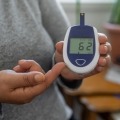Moods and Blood Sugar in Children: What’s the Connection?
By Alexandra Frost
.jpg) While adults might see a clear connection between mood and glucose changes, for kids it can be more convoluted. Here's why mood changes happen and tips for how to manage them.
While adults might see a clear connection between mood and glucose changes, for kids it can be more convoluted. Here's why mood changes happen and tips for how to manage them.
When Rex Pearl, an 11-year-old boy in Chicago who has diabetes, has a test or performance coming up, his blood sugar sometimes spikes. His adrenaline affects his numbers, which he and his mom, Nicole Pearl, have paid attention to as they learn the complicated relationship between moods and blood sugar levels.
“For Rex, oftentimes the highs are typically more triggered by what he’s eaten, but there are also so many other variables – does he have a test coming up that he’s nervous for? There are so many different things that could be connected, it’s hard to fully pinpoint what that mood could be,” Nicole said.
Luckily, this hasn’t resulted in any extreme or dangerous situations for Rex, but it can take a while for his levels to return to normal after mood changes. Nicole is looking ahead to determine what next steps they might have to take as Rex moves from fifth grade into later grades, and issues such as text anxiety might intensify.
“I wonder in high school how if he’s high and taking a test, will that be harder? Those are things we’ll have to visit,” she said.
This phenomenon is gaining more traction with scientists as they explore a growing body of evidence providing the relationships between mood and glucose highs and lows, the University of Michigan reports. And the relationship goes both ways – inconsistent blood sugar levels among people with diabetes have been shown to result in more negative moods and a generally lower quality of life.
In addition, hyperglycemia (high blood sugar) has been linked to anger or sadness, while hypoglycemia (low blood sugar) has been associated with nervous feelings. But of course, symptoms might be different for everyone, and in children, additional complicating factors are involved.
Here’s what to know about moods and blood sugar levels so your family can be well-informed on the potential scenarios and reasons behind mood changes.
A multitude of variables
While an adult, especially one who has had diabetes for many years, might see a clear relationship between a specific mood and glucose changes, for kids and their families it can be more convoluted.
“It’s stress. It’s food. It’s insulin. It’s exercise and 40 other things that impact the blood sugar,” said Dr. Henry Anhalt, endocrinologist and chief medical officer at Embecta.
It’s a bit of a chicken and egg type scenario when it comes to all the variables at play, he explained.
“What comes first? Is it the chronic illness and blood sugar values that are out of range causing you to be irritable? Or is that irritability, that stress, affecting your blood sugars? Adolescence is a time of turmoil – it’s not necessarily due to their diabetes,” Anhalt said.
This is a significant point for families to understand because sometimes those he works with think that if their glucose levels are out of control – and then fixed – their child’s mood should be much better. However, sometimes it’s just them working through phases of adolescence.
What a blood sugar-induced mood looks and feels like
Is your typical bad day the same as someone having dangerously low blood sugar? Maybe not. Anhalt said that someone dealing with extremely low blood sugar can seem very irritable.
“They can get as confused as someone who is drunk,” he explained. “It’s a miss because their mood and personality have been deeply affected by their brain not getting enough sugar. Their thought processes are all jumbled.”
One way he helps patients determine if it’s due to blood sugar issues or another concern is if the person sees a significant mood difference after glucose rises again. More sustained states of ketoacidosis can also make people feel unwell, which could come with a change in mood.
Anhalt recalled noticing a friend with type 1 diabetes was “babbling” and not making any sense, even though he wasn’t irritable, but he was “off.” That’s because he was having an episode of profoundly low glucose levels. This shows the mood changes might look a bit different for everyone.
Diabetes management struggles that impact mood
As most people with diabetes can attest to, having the condition for life can be exhausting in itself. That exhaustion can manifest as a sense of failure, which can manifest as a mood change for young children.
Everyday diabetes control can leave kids feeling frustrated, discouraged, and worried, especially if they aren’t seeing positive results in spite of trying hard at managing their condition.
“You’re doing the best you can, and you look at the continuous glucose monitor and the number isn’t where you want it to be. Your sense of self-efficacy is destroyed. You [think] ‘I failed, I failed.’ And you go to the doctor’s office and they go, ‘You failed,’” Anhalt said. “The irritability and mood for a young child or adolescent can be devastating and certainly affect mood.”
While it might seem like “taking a break” or opting out of diabetes care isn’t an option, Anhalt said it’s quite common for those wearing diabetes technology to take a break. It’s a decision and a valid question to bring up to your healthcare team and to do so under their supervision.
Tips for families with blood sugar levels and mood changes
Just acknowledging and learning more about the relationship between mood changes and diabetes is an essential first step. Accepting this as a truth for families can help parents be supportive and not use shame, blame, or expectations, Anhalt said.
In addition, intentionally educating kids can help them understand what’s going on in their bodies and minds. “You can say, ‘Look, if your blood sugars are out of range, you may be experiencing these kinds of feelings,’” he said.
Keep in mind that children might not be able to monitor their mood when they’re in the midst of a mood swing. Instead, it might mean educating others around the child (like their teachers), to watch out for mood changes.
Finally, working with a child’s medical team, including mental health providers, can help diagnose and treat any ongoing mental health conditions that might be happening at the same time – for diabetes-related reasons or not.
Families can also access support resources as well, as it can be trying for anyone to parent a child navigating mood swings, whether they are caused by diabetes or typical stages of growing up.








